Arugula is full of nutrition and one of the easiest cool-weather crops to grow. Here’s everything you need to know about growing arugula!
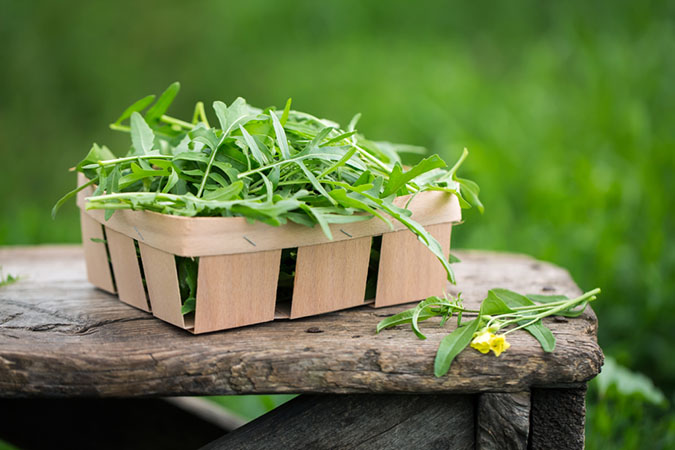
Growing Arugula: The Rocket in Your Salad Bowl and Garden (With Recipe)
One of my favorite things to do at the end of an exhausting and stressful day is go home, put on some comfy clothes, and pour myself a giant serving of … arugula. I know arugula might not be the most obvious choice for everyone, but those little rocket-powered leaves are exactly what my body needs to hit the reset button and transition from tough day to a relaxing evening.
This article on growing arugula is part of our Green of the Month series. To read the rest of the articles in the series, click here.
Something in the peppery—but also creamy, buttery, and almost meaty—taste of those almost-impossible-not-to-grow little greens just gives me a rocket-like boost. And since “rocket” is actually the common name for arugula in the UK and France (actually, roquette in France—but that’s French for “rocket”), I suspect I am not alone in my appreciation of the power of these peppy plants.
The really great thing about growing arugula is that many of you will even be able to plant it right now for a really early spring crop of super-food-rated greens.
The Goods on Growing Arugula
Nutty Nutritiousness
If you are looking for a nutty-tasting, low-calorie snack option that offers a vitamin, mineral, and phytochemical power punch, you can eat one-third of a teaspoon of almonds at 5.4 calories. (Actually, this is probably not even the equivalent of a single almond.) Or, you can eat a cup full of arugula at only 5 calories.1)https://www.nutritionvalue.org/comparefoods.php?first=12062&second=11959
I can tell you from experience that you will feel a whole lot more satisfied eating the arugula than the caloric equivalent in almonds. Which is why arugula is a great option if you are trying to cut calories and simultaneously increase your energy levels. Arugula is high in fiber and water content, both of which contribute to your satisfaction level when eating it.
Like mustard greens, arugula is high in calcium and in vitamins A and K. In addition, arugula has lots of glucosinolates, which may help protect against cancer.2)https://guidedoc.com/arugula-health-benefits-superfood-cancer-prevention
You May Also Enjoy:
“Mustard Greens: What You Need to Know Before You Grow (With Recipe)”
“Chard en Garde Manger: The Delicious 3-Season Green for Food Security”
Like spinach, arugula also has high levels of iron. Calorie for calorie, arugula has more iron than beef … by a long shot. Just 25 calories of arugula will get you 8% of your daily iron intake. Meanwhile, you’d need to eat about 160 calories of grass-fed ground beef to get that same quantity of iron.3)http://superfoodprofiles.com/arugula-health-benefits
Just in case you are not totally convinced: In terms of calories consumed, arugula also contains high levels of folate, B vitamins, and trace minerals like magnesium, manganese, potassium, and chlorophyll (which is believed to be a good blood cleanser).
Delicious

Image by Hans Braxmeier from Pixabay
Now for the best part. Arugula tastes amazing. It is so darn delicious that I am constantly snapping off leaves in the garden to pop in my mouth. And, as with potato chips, once you start you just can’t stop.
Arugula can spice up almost any meal. It can be used as a stand-alone salad with just a splash of oil, vinegar, and salt. You can mix it with other greens to make a mesclun salad. It is incredible wilted on top of omelets or pizzas, or made into a pesto and served over pasta or on crusty bread with mozzarella. You can even puree it and add it to smoothies, toss it in soups, and so much more.
Easy to Grow
Arugula is one of the easiest cool-weather crops you can grow. And if you don’t mind it being a little spicy and stemmy, you can even grow it all summer long. Giving it a little mid-summer shade will help extend your arugula season.
The wild variety of arugula, in fact, grows like a weed. You can grow arugula as an annual in the garden or as a self-seeding, short-lived perennial in your edible landscape. It’s even great for growing in containers. The plant is mature in about 40 days, but you can also cut baby greens earlier.
If you like great-tasting, low-calorie, high-nutrient-density greens that are as easy to grow as it gets, then arugula is for you!
Recipe
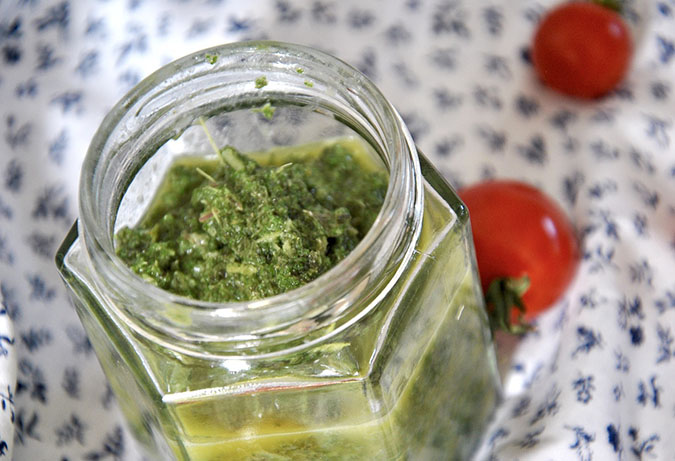
Image by Siobhan Dolezal from Pixabay
In case you need more convincing that you need arugula in your garden this year, then get yourself a box of it from the grocery store now and make your own homemade arugula pesto to spread on bread, toss with pasta, or use to dress up your chicken breast.
Easy Arugula Pesto Recipe
- 2 c. arugula, finely chopped
- 1 tsp. minced garlic (or a tablespoon if you are a garlic junky like me)
- ¼ c. finely grated Parmesan or other hard cheese
- ¼ c. olive oil for thick, spreadable pesto, or ½ c. olive oil for saucy pesto
- 2 T. chopped nuts (Pine nuts are expensive and don’t grow well in my region. I use almonds, pecans, or even sunflower seeds in my pesto.)
- Salt and pepper to taste
Put all this stuff in a bowl and mix. Serve or refrigerate. (See, I told you it was easy!)
If you have a food processor, you can skip all that pre-chopping. Instead, throw your chunks of Parmesan, whole nuts, and garlic cloves into your food processor and pulse until they are finely crumbled. After that, toss in your arugula and pulse 2 or 3 times until the arugula is chopped. Finally, stir in your olive oil and salt and pepper.
Seriously, the hardest part about this recipe is waiting to sample some!
A Few Cautionary Things to Know About Growing Arugula
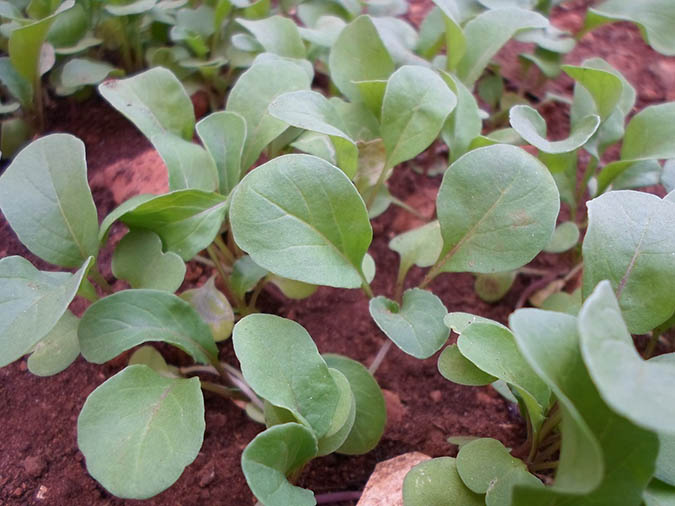
Image by REINALDO MANOEL DA SILVA REINALDOCDI from Pixabay
Now, in my opinion, there’s no downside to growing arugula. But, there are a few things you may want to be aware of before you plant.
It’s a Cole Crop
Even though most of us think of arugula as a lettuce, for the purposes of crop rotation, it’s actually a cole crop like cabbage. Avoid planting it after other brassicas like cabbage, broccoli, cauliflower, kale, etc.
Self Spreads
Since we grow most of our food at home, arugula gets bonus points for its eagerness to spread itself around my yard. If it shows up somewhere that I don’t want it to grow, I just dig it up and move it somewhere else. But if you are one of those meticulous gardeners who hates to deal with unwanted plant volunteers, then make sure you do not let this plant flower (even though the flowers are great for pollinators, as well as being edible and delicious).
You May Also Enjoy:
“Calendula: Lymph Mover, Detoxifier, Cancer Fighter, and Skin Beautifier”
Short Shelf Life
Unlike many of the other cole crops—such as cabbage, which can keep for weeks, months, or even years (as sauerkraut)—arugula is best consumed fresh or, if kept in the fridge, within a couple of days after being harvested.
Flea Beetle Favorite

Keep an eye out for flea beetles when you’re growing arugula. Image by Brett Hondow from Pixabay
As the weather warms, my arugula leaves often have tiny little holes in them that evidence the fact that I am not alone in my love for this stuff.
Flea beetles seem to munch on it almost as much as I do. Since the minuscule portions those pests eat seem to have no effect on the production of the plants, and since I’m an organic gardener, I just resign myself to share. But if it bothers you, you can use whatever organic pest-control method you use on your other cole crops to discourage flea beetles.
By now, I’m hoping that your mouth is watering and your inner gardener is begging you to grow some arugula. So let’s dig into the details of how to plant.
Growing Arugula
Soil Preparation
Like most cole crops, arugula likes well-prepared garden soil with a pH of 6.2 to 6.8. But, it will grow in less-than-ideal conditions, too. Just throw an inch or 2 of compost on your existing garden bed or row, water well, and get ready to plant.
If you are brand new to gardening and need some ideas for how to prepare your beds, check out this post: “The Easiest Way to Prepare a Garden Bed”
You May Also Enjoy:
“Sheet Mulching: Build Soil, Thwart Weeds, and Make Your Garden Fertile“
“Composting the SCARY Stuff—Meat, Dairy, Bones, and Human Waste!”
Seed Starting
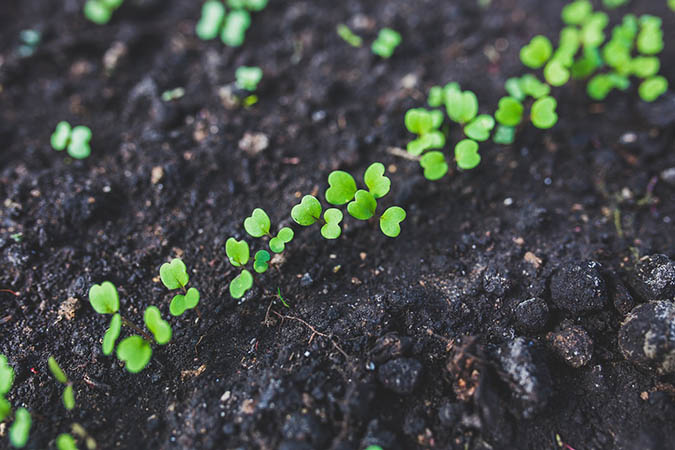
Image by Karolina Grabowska from Pixabay
You can start arugula indoors under grow lights if you want to. But in my experience, it really does best direct planted. I just scatter the seeds on my soil, then cover them with about a quarter inch of compost and water. Seed guides say it takes 5-7 days for germination, but I usually see my little seedlings popping up in about 3-4 days.
You May Also Enjoy:
“How to Start Seeds Like a Professional Grower”
If you like a more uniform appearance, you can also use your finger to make a little trench row to plant in. Make your finger rows about 3 inches apart and plant seeds the whole way down. Then push just a bit of soil back over the seeds.
Arugula will germinate best in soil temperatures of 40-55ºF. Keep surface soil moist until plants have several true leaves.
Young Plant Care
Arugula will grow with almost no care so long as you get a little rain each week. However, you will get the biggest yields with regular watering. Annual arugula has fairly shallow roots, so watering deeply on a weekly basis and shallowly every couple of days will help maintain consistent moisture in the root zone.
Also, if you live in an area that has big temperature fluctuations (like 40ºF one day and 75ºF the next), the best way to keep your arugula from bolting is to mulch around your plants and keep them consistently watered with cool water.
Mature Plant Care
Arugula is ready in about 40 days and can be used as a come-and-cut crop for a couple of months. But since it is quick to bolt and can get stemmy and extra peppery as it ages, rather than worry about long-term mature plant care, think about next-round seed starting.
You May Also Enjoy:
“7 Ways to Use Pine Trees for Food and Medicine, Year-round”
Arugula is one of those plants you want to start often. Some people plant more arugula once a week, but personally, I go for about once every 3 weeks.
Because arugula is so fast-growing, I tend to use it almost like a cover crop in my beds that will be primarily used for warm-weather crops. But you can also add more compost to your existing beds and sow in the spaces between your mature plants.
Harvesting
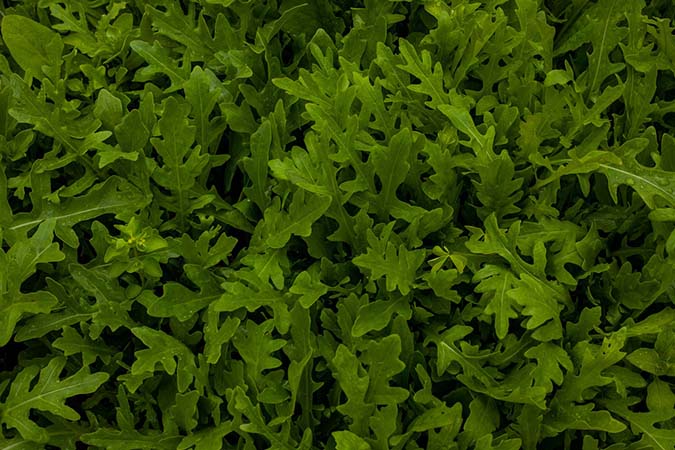
Image by Jasmin Sessler from Pixabay
I like to start picking baby greens when the plants are about 2-3 weeks old. I’ll just take one or two leaves from each plant to snack on as I do my gardening chores.
Once the plants are growing well and have leaves that are about 3 inches in length, you can harvest about one-third of the plant about once a week. Trim off the larger, older leaves first.
You May Also Enjoy:
“Special Challenges to Managing NPK in the Organic Garden”
If you want to eat arugula every day, then mentally divide your arugula patch into seven sections based on days of the week. For example, harvest your Monday section only on Monday, your Tuesday section only on Tuesday, etc.
If you are planting continuously, as your first plants begin to exhaust, you can start cutting from your next round.
Varieties of Arugula
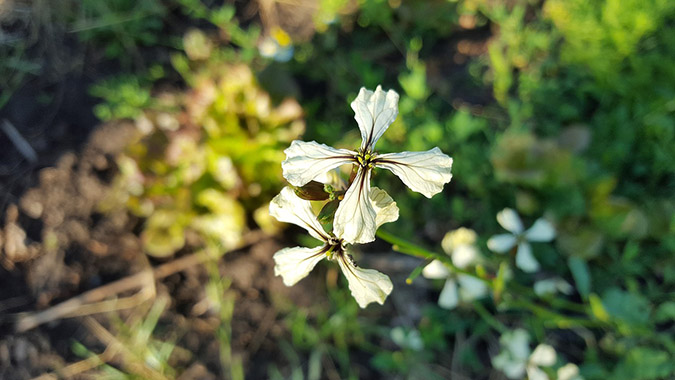
The flower of Eruca sativa (common arugula); Image by SanduStefan from Pixabay
There are two basic varieties of arugula to choose from—wild and common.
Wild arugula has smaller leaves and tends to be more flavorful. However, it is also more stemmy and is harder to harvest. It grows a bit slower than common arugula.
You can generally find two different kinds of wild arugula seeds for sale:
- Diplotaxis tenuifolia, often referred to as wild rocket or Sylvetta, has yellow flowers and can be grown as a short-lived perennial in some areas.
- Diplotaxis erucoides, also called wild arugula or wasabi arugula, is an annual with white flowers.
There is also a variety called Diplotaxis muralis, or wall rocket, that grows wild in poor-quality, disturbed soils. You probably don’t want to plant this one in your vegetable garden. But sometimes seed sellers will also refer to Diplotaxis tenuifolia as wall rocket. So, make sure you are checking Latin names on seed packets to get the variety you really want.
You May Also Enjoy:
“All Hail, Kale! Growing Kale at Home (With Recipe)”
Common arugula, Eruca sativa, has much larger leaves and a milder taste than wild arugula. It is slower to bolt in the heat. It also grows faster and produces more leaves per plant than wild varieties. The flowers are white.
For heavy, consistent, and easy-to-harvest leaf production, choose common arugula. For effortless growing, spectacular taste, but more work on the harvesting end, choose wild arugula.
For either variety, you can find improved versions from different seed retailers that may have been selected over time for different flavor profiles and growth habits. So, feel free to try seeds from different distributors and then save your own seeds from your favorite plants.
Unconventional Growing Tips for Adventure Gardeners
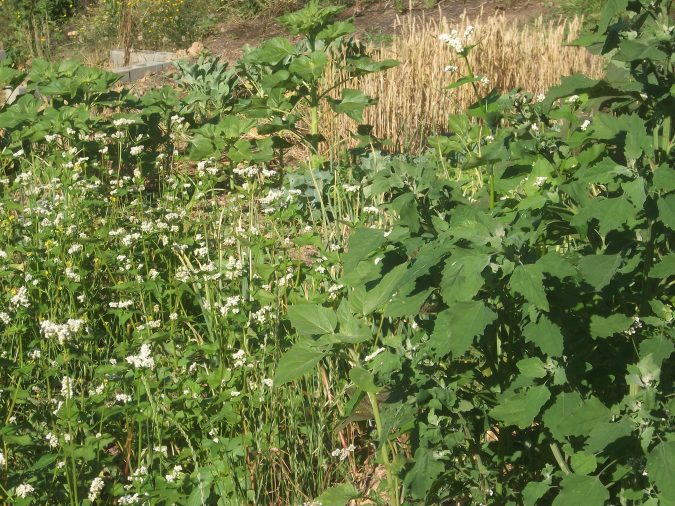
Interplanting your arugula with buckwheat may help it germinate in mid-summer.
Since I am a total arugula addict and really want to eat it year-round, I discovered a trick for germinating arugula outdoors, even in mid-summer. I interplant my arugula with buckwheat. The buckwheat comes up quickly, providing some shade and a bit of a microclimate for the arugula.
I don’t know if this will work in extreme heat, but it has worked for me in 80-90ºF temperatures as long as I keep my buckwheat/arugula patch well watered.
You May Also Enjoy:
“Companion Planting Favorites (Your Answers to the Question of the Month!)”
When grown late in the season, the arugula will bolt and flower more quickly.
I usually only get a couple of cuttings before the plant sends up flower shoots. At that point, I just let it. Mixed in with the buckwheat flowers, it makes for great pollinator food. (In the photo above, you can see arugula growing alongside my lamb’s quarters—another great green that grows well wild and even better in your garden! I think the combination makes for a really pretty pollinator plot.)
I hope you let this wonderful little rocket plant take flight in your garden and on your plate this year!
What Do You Think?
We’d also love to hear your ideas and suggestions for using and growing arugula. Please leave us a line in the comments section below.
____________
This is updated version of an article that was originally published on March 5, 2018. The author may not currently be available to respond to comments, however we encourage our Community members to chime in to share their experiences and answer questions!
The Grow Network is a participant in the Amazon Services LLC Associates Program, an affiliate program designed to provide a means for our team to earn fees for recommending our favorite products! We may earn a small commission, at no additional cost to you, should you purchase an item after clicking one of our links. Thanks for supporting TGN!

Tasha Greer is a regular contributor to The Grow Network and has cowritten several e-books with Marjory Wildcraft. The author of “Grow Your Own Spices” (December 2020), she also blogs for MorningChores.com and Mother Earth News. For more tips on homesteading and herb and spice gardening, follow Tasha at Simplestead.com.

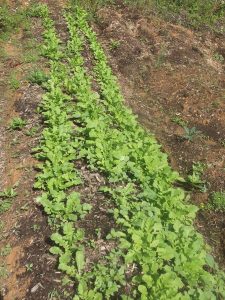







COMMENTS(13)
You got me hungry!
I think arugula may need it’s own musical ballad, the next time you can’t garden on a rainy day! Thanks for reading. Tasha
I can hear Scott and the music, that’s not Disney, ….the tasty leaves fool you into thinking it’s a lettuce variety!
Great article, thanks! I am going to plant a few rows tonight!
Thanks for reading! That sneaky arugula making you think it’s just an ordinary lettuce… Happy arugula planting and eating!
Hi Tasha,
excellent artilce. I too am an Arugala lover 🙂
Here in Texas it can get a bitter as we often have ‘warm spikes’ but I still love it with that tang it has.
That taste is super important for good digestion too. It is one of the tastes that is not common in the SAD (Standard American Diet).
I am lovin’ this series on greens…
You are so right about SAD! I have actively cultivated my bitter taste pallet for years and I feel so much better when my diet includes foods on that spectrum. I’d love for you to try the arugula buckwheat interplanting trick in your planting region. We get pretty hot summers here too and that seems to keep the bitter in check. Thanks for reading Marjory!
My toes love dipping into your fine soil of comfort and info of the finest in nature!???✌️
Thanks – I too am an arugula lover :-), and it grows year round in our Namibian heat! I used to think of it as a ‘decoration’, but because it grew so well, we started eating it as a salad – now it’s our favourite!
I started arugula for the first time a few weeks back. I put it in a shady spot on my patio last night after starting to read this article because we’ve been having highs in the 80s already. Thanks for the info.
Any ideas how to stop the butterflies from laying eggs on arugula? The caterpillars tend to get more arugula than I ever do. I remove the eggs when I see them but I can’t check under every leaf every day.
For me, the easiest way to keep out the pests for brassica family crops like arugula and cabbage is to use floating row covers. If you use a light weight cover, you won’t lose too much light and it won’t overheat the plant. Plus, since you can water right through them, you only need to remove them to harvest. I also often use cut, dried mint as a mulch under brassicas to confuse pests. It works pretty well if you reapply the mulch when the mint fragrance diminishes. Good luck with your arugula crop! Tasha
I love arugula. I’ve been eating it since the first time I tasted it yrs. ago. Who wants lettuce when you can have arugula. I have a heaping bowl for dinner and for supper. I’m growing some that has now flowered. Where are the seeds in what I have grown so I can plant them and grow some more?
I use arugula in place of spinach for arugula artichoke dip it is amazing for that. It has grown all winter in my greenhouse munching right off the plant is best!